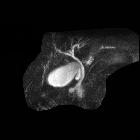Todani classification of bile duct cysts








The Todani classification of bile duct cysts divides choledochal cysts into five groups.
Classification
Type I
- account for 80-90% of all bile duct cysts
- characterized by fusiform dilation of the extrahepatic bile duct
- a subclassification has been proposed
- Ia: dilatation of extrahepatic bile duct (entire)
- Ib: dilatation of extrahepatic bile duct (focal segment)
- Ic: dilatation of the common bile duct portion of extrahepatic bile duct
Theorized to form as the result of reflux of pancreatic secretions into the bile duct via an anomalous pancreaticobiliary junction. Some believe them to arise from ductal plate anomalies.
Type II
Also known as a bile duct diverticulum. Account for 3% of all bile duct cysts. Saccular outpouchings, representing a true diverticulum, arising from the supraduodenal extrahepatic bile duct or the intrahepatic bile ducts.
Type III
Also known as a choledochocele:
- account for 5% of all bile duct cysts
- represent protrusion of a focally dilated, intramural segment of the distal common bile duct into the duodenum
Choledochoceles may be successfully managed with endoscopic sphincterotomy, surgical excision, or both, in symptomatic patients.
Type IV
Multiple communicating intra- and extrahepatic duct cysts:
- second most common type of bile duct cysts (10%)
- subdivided into subtypes:
- type 4a: fusiform dilation of the entire extrahepatic bile duct with extension of dilation of the intrahepatic bile ducts
- type 4b: multiple cystic dilations involving only the extrahepatic bile duct
Type V
Also known as Caroli disease, which is a rare form of congenital biliary cystic disease manifested by cystic dilations of intrahepatic bile ducts. Association with benign renal tubular ectasia and other forms of renal cystic disease.
History and etymology
The Todani classification (1977) arose out of the earlier Alonso-Lej classification (1959). The Todani classification added type V (Caroli disease) to the earlier classification.
The Todani classification scheme has been called into question in the surgical literature, with claims that it may inaccurately link multiple distinct processes into a spuriously coherent grading scheme . Specifically, it is questioned whether types II, III, and V are pathophysiologically related to I and IV. Some also think the difference between I and IV may be artificial.
See also
Siehe auch:

 Assoziationen und Differentialdiagnosen zu Todani-Klassifikation der Gallengangszysten:
Assoziationen und Differentialdiagnosen zu Todani-Klassifikation der Gallengangszysten:
